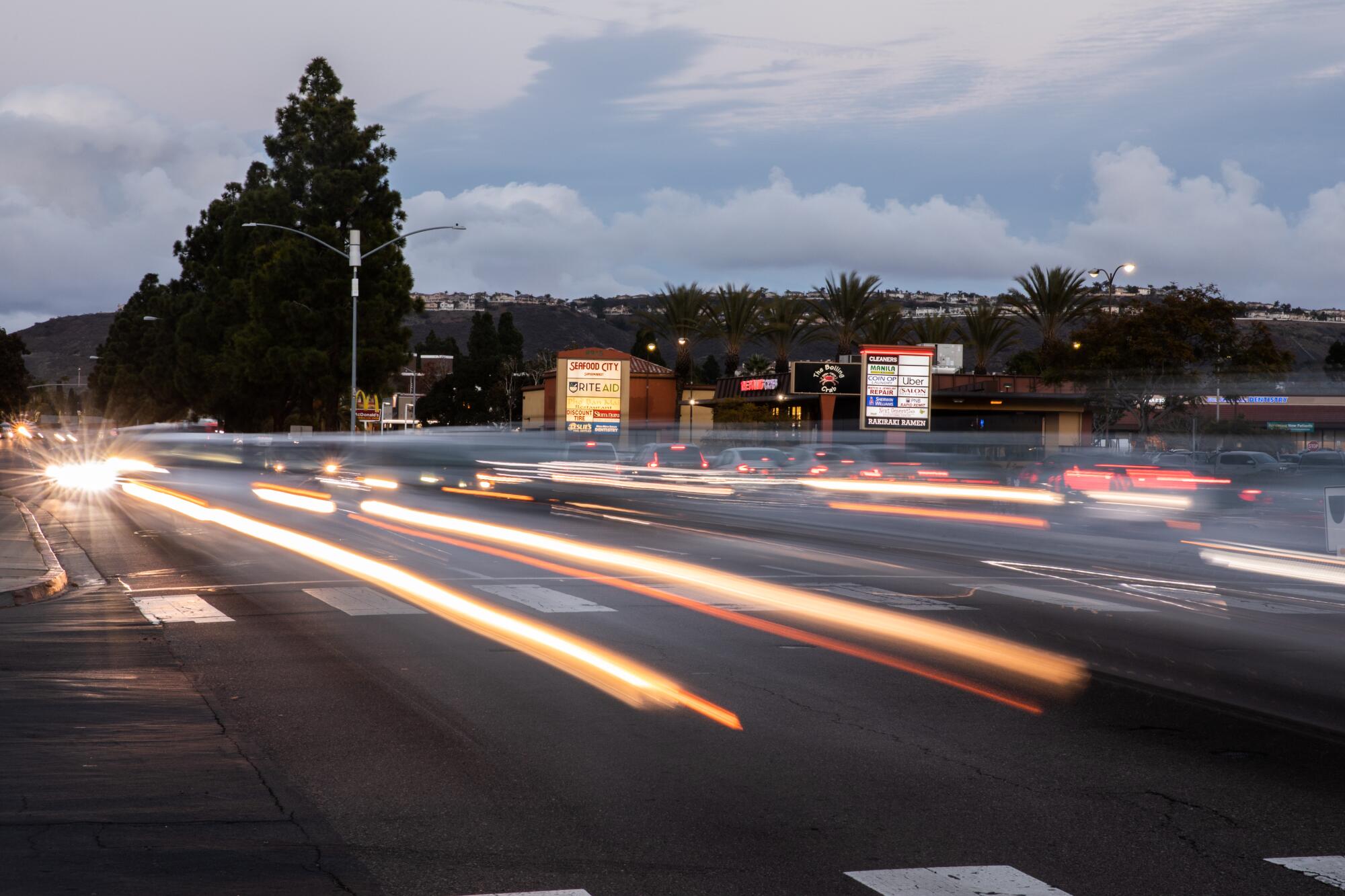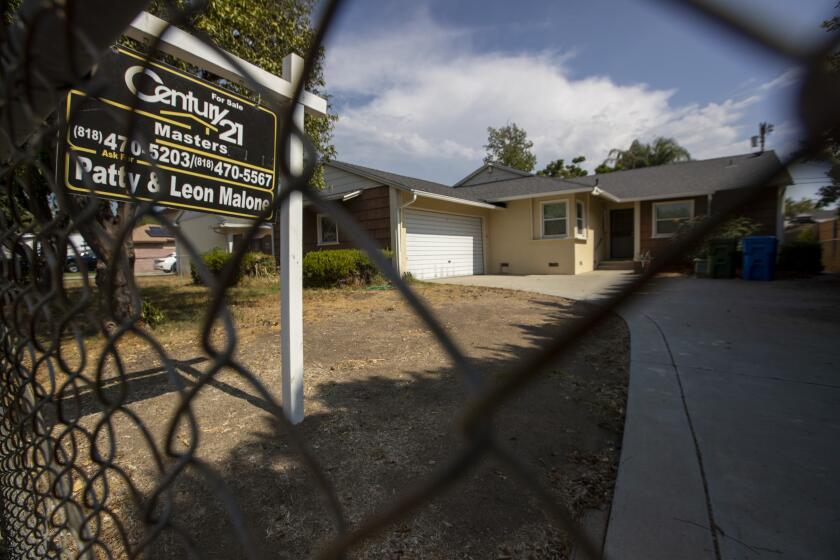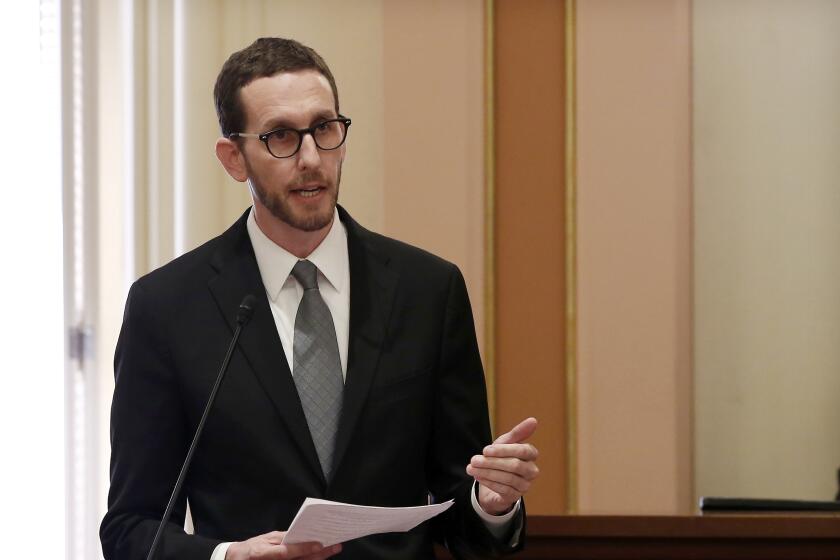
- Share via
SAN DIEGO — The city of San Diego aims to transform the car-dependent neighborhood of Mira Mesa and its suburban strip malls into several pedestrian-friendly urban villages featuring high-rise housing and less traffic, under a new growth blueprint approved Monday.
It’s the first time San Diego has tried to solve its housing crisis by rezoning large swaths of commercial land for high-density housing, but the so-called innovation districts in Miramar and Sorrento Valley — hubs of the biotech industry — would remain mostly unchanged.
To ease congestion and make Mira Mesa a more appealing place to live in coming decades, developers would get incentives to break up car-centric superblocks with new streets and to build walking bridges over some major roadways.
Some vehicle travel lanes on major streets would be transformed into lanes for buses or bikes under the new growth blueprint, which also includes ambitious proposals for features such as aerial skyways.
State lawmakers are set to vote on a bill that aims to give Los Angeles until fall 2024 to rezone the city for a quarter-million new homes.
City officials and local developers touted the plan, which was approved unanimously by the City Council on Monday, as a balanced effort that will help solve San Diego’s housing crisis and make Mira Mesa a more livable area.
Critics, including Mira Mesa neighborhood leaders, said the plan would bring many more residents without the necessary infrastructure and parks to support them all.
Environmental advocates also complained the plan doesn’t do enough to shift commuters away from cars toward transit, biking and walking. The percentage of people expected to commute alone in a car would drop from 54% to 39%, a much more modest drop than citywide goals.
The plan, the first update to Mira Mesa’s growth blueprint since 1992, would increase the neighborhood’s population from 78,000 to 143,000 primarily by adding 24,000 new homes, mostly in high-density developments.
Some commercial areas would be rezoned, but the number of jobs in the community would still rise from 85,000 to 117,000.
Mira Mesa, one of San Diego’s largest neighborhoods by both population and acreage, is bordered on the east by Interstate 15, on the west by I-805, on the south by Marine Corps Air Station Miramar and on the north by Los Peñasquitos Canyon, Torrey Hills and Carmel Valley.
Mira Mesa is the city’s third-largest employment center behind Kearny Mesa and University City.
“As one of San Diego’s largest communities by land area, population and employment, Mira Mesa will greatly benefit from having more mixed-used areas where people can live, work and play,” said Mayor Todd Gloria, adding that the plan calls for homes for a variety of incomes and ages.
Councilmember Chris Cate, whose district includes Mira Mesa, said he’s optimistic city officials will follow through on promises to prioritize needed infrastructure in San Diego neighborhoods that are willing to accept the most growth.
Cate praised the plan as something that will boost an already thriving neighborhood.
You need to make more than $220,000 a year now to afford a house in Los Angeles, thanks to rising mortgage rates and inflation.
“Despite what some might say, Mira Mesa is a very vibrant and diverse community,” he said.
The San Diego Regional Chamber of Commerce and the local chapter of the Building Industry Assn. also praised the plan as a boon for the economy and significant progress toward solving the local housing crisis.
“The only way we’re going to solve the housing shortage is to provide opportunities for more housing,” said Matt Adams of the BIA. “It’s an appropriate balance between residential and non-residential.”
Critics said the plan is developer-driven and would make an already-congested neighborhood much worse by allowing intense growth without the infrastructure they say is needed to support it.

“The plan will increase the population of Mira Mesa by about 50,000, but it provides very little infrastructure beyond that already in place,” said Jeff Stevens, chairman of the Mira Mesa Community Planning Group, which had 13 proposed amendments to the plan get rejected by city planning staff.
“We have no estimates of the costs of the public facilities identified in the plan,” Stevens said. “We have no estimates of how much money will be available and we can’t predict when any of the public facilities will be constructed. These are serious deficiencies.”
The plan identifies more than 91 lane miles of new bike lanes and routes. It also proposes more than 100 acres of new parkland, 17 miles of trails, two new recreation centers, one new aquatic complex and a new fire station.
But critics note that locations aren’t identified for many of the new amenities and that land will only become scarcer over time, making available sites steadily harder to come by.
Senate Bill 4 would let religious groups and nonprofit colleges build homes on excess land, but lawmakers will need to make a deal with unions on the proposal.
The plan calls for rapid buses on Carroll Canyon Road, which would be extended westward. There would be “flexible lanes” for buses and bikes on Camino Ruiz, Westview Parkway, Mira Mesa Boulevard, Miramar Road, Black Mountain Road and Camino Santa Fe.
A key factor mitigating future traffic congestion is a planned extension of the San Diego Trolley through North Park, Kearny Mesa and the western edge of Mira Mesa, with a station planned for Sorrento Mesa when the new purple line is complete in 2045.
City officials said there are also plans for connection to the Coaster and the blue line extension of the trolley, which has stations in nearby University City.
Annexed to the city in 1958 along with Miramar and land east of Del Mar, Mira Mesa was developed mostly in the 1970s when car-dependent strip malls were popular. City officials say a key goal of the plan is to revamp that development model in the community.
More to Read
Sign up for Essential California
The most important California stories and recommendations in your inbox every morning.
You may occasionally receive promotional content from the Los Angeles Times.

















